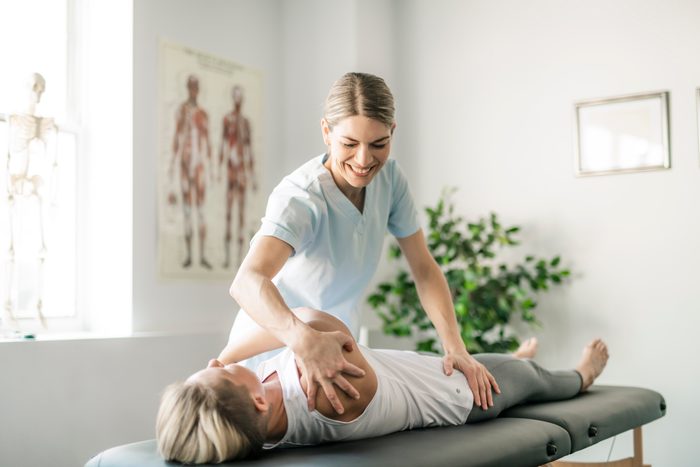I Tried Fascial Stretch Therapy for My Clicking Shoulder—Here’s What Happened

Fascial stretch therapy is like a combo of physiotherapy, yoga and massage. I tried it to see if it could ease my aches and pains.
My left shoulder won’t shut up. It started off with a few soft clicks, built to a burst of rapid pops and crescendoed in a single lusty crack. Face down on a massage table, I’m mortified, but registered kinesiologist Emily Hamilton—who has hooked her arm around mine to guide that noisy shoulder further back—is used to this sort of soundtrack. Bodies can be loud, especially when encouraged to roll in a direction other than their typical forward slump.
(Related: 4 Stretches to Improve Range of Motion as You Age)
In a back room at Toronto’s Flxme Studio, Hamilton is leading me through a series of assisted stretches meant to release my fascia—the thin layer of connective tissue under the skin that surrounds our organs, bones, muscles, arteries and nerves. “You can almost think of fascia as a pair of pants, and like pants, it can get really tight and start to restrict your movements,” Hamilton says. To get that connective tissue loose again, fascial stretch therapy involves applying gentle traction to the joints and muscles to create space for a greater range of motion. “It’s like a tune-up for the body,” Hamilton says. “Instead of just focusing on a sore muscle or joint, we’re unlocking all different sets of muscles to help with mobility and take care of the body as a whole.”
And it feels fantastic, like some sublime combination of physiotherapy, yoga and massage. My hip flexors and hamstrings—which, due to diligent running and much less diligent stretching, are always tight—release onto the table; as Hamilton hikes my ankle onto her shoulder and lengthens my quadriceps, I begin to make sounds of my own. “We all need to bring more movement into our bodies,” she says. And while it’s very nice to have a lovely stretch therapist do the work for me, Hamilton says doing a couple of basic movements on our own can pay enormous dividends. “Just rolling our shoulders around or doing a few twists of the back or swinging a leg side to side when you’re doing the dishes—it all counts,” she says. “Something as simple as that will still have a big effect.”
Next: How Tai Chi Can Help Build Muscle Strength and Flexibility




